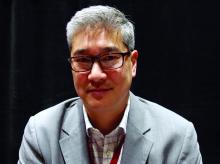SAN FRANCISCO – Antibiotics might help in pediatric acute-onset neuropsychiatric syndrome (PANS) even if there’s no apparent infection, according to Kiki Chang, MD, director of PANS research at Stanford (Calif.) University.
The first step at Stanford is to look for an active infection, and knock it out with antibiotics. Dr. Chang has seen remarkable turnarounds in some of those cases, but even if there’s no infection, “we still do use antibiotics.” There are positive data, “although not a lot,” indicating that they can help. Some kids even seem to need to be on long-term antibiotics, and flair if taken off long after infections should have been cleared.
“We don’t know what’s going on. We try to stop antibiotics if we can; if patients relapse, we think the benefit [of ongoing treatment] outweighs the risks. Some kids just have to be on antibiotics for a long time, and that’s an issue.” Perhaps it has something to do with the anti-inflammatory properties of antibiotics like azithromycin and amoxicillin, or there might be a lingering infection, he said at a psychopharmacology update held by the American Academy of Child and Adolescent Psychiatry.
PANS is a recently coined term for the sudden onset of obsessive compulsive disorder (OCD) within a few days of an infection, metabolic disturbance, or other inflammatory insult. Anxiety, mood problems, and tics are common. There might be severe food restriction – only eating white foods, for instance – that are not related to body image.
PANS broadened the concept of pediatric autoimmune neuropsychiatric disorders associated with streptococcal infections (PANDAS), which was first described in 1998, although it’s been known for generations that acute streptococcus infections can lead to abrupt psychiatric symptoms.
PANS is the topic of ongoing investigation, and Dr. Chang and many others are working to define the syndrome and its treatment, and trying especially to determine how PANS differs from typical OCD and other problems with more insidious onset. The idea is that inflammation in the patient’s brain, whatever the source, triggers an OCD mechanism in susceptible patients. As a concept, “we believe it’s true,” he said.
For now, it’s best to refer suspected cases to one of several academic PANS programs in the United States, as diagnosis and treatment isn’t ready for general practice, he said.
If more than antibiotics are needed, Stanford considers targeting inflammation. Some children respond to easy options such as ibuprofen. Dr. Chang has seen some helped with prednisone, but treatment is tricky. There might be an occult infection, and PANS can present with psychiatric issues that prednisone can make worse, including depression and mania. Intravenous immunoglobulin is another of the many options, “but we really need about four treatments” to see if it helps.
Cognitive behavioral therapy and family support also helps. As for psychotropic medication, “we often use them, but they rarely take away the acute symptoms,” and PANS children seem especially sensitive to side effects. “I’ve seen many of them become manic on SSRIs. I’ve seen some of them have very strong [extrapyramidal symptoms] with atypical antipsychotics. You have to be very careful; we don’t have any good studies” of psychiatric drugs in this population, he said.
At the moment, PANS seems to be more common in boys than girls, and most patients have a relapsing/remitting course and a family history of autoimmune disease. Suicidal and homicidal ideation can be part of the condition.
Dr. Chang believes PANS could be part of the overall increase in autoimmune disease and psychiatric disorders in children over the past few decades.
“We have more kids who have special needs than ever before,” large, objective increases in bipolar, autism, and other psychiatric problems, as well as increases in psoriasis, nut allergies, and other autoimmune issues. “What causes it is harder to say, but there has been a change for sure in kids and their immune system development that does affect the brain, and has probably led to more neuropsychiatric disturbances,” he said.
“No one talks about it. Everyone thinks that it’s some sort of pharmaceutical industry conspiracy” to sell more drugs by increasing scrutiny of children. “I think it’s caused by something in the environment interacting with genetics,” whether it’s infections, toxins, or something else. “We don’t know. Any kind of inflammation can be a trigger” and “we know inflammation” is key to “many psychiatric symptoms. I do think there’s something going on with kids over the last 30 years,” he said.
Dr. Chang is a consultant for and/or has received research support from Bristol-Myers Squibb, Lilly, Merck, GlaxoSmithKline, and other companies.


